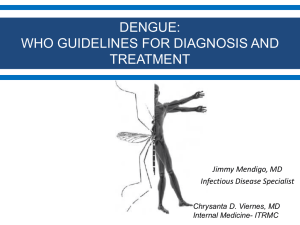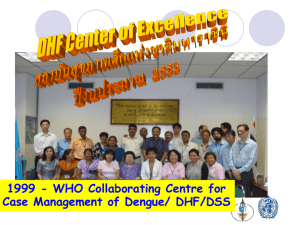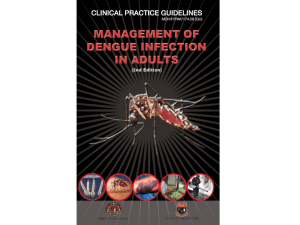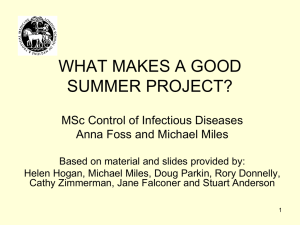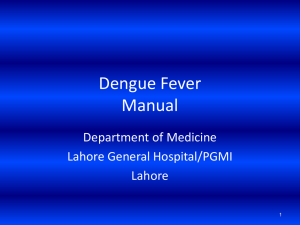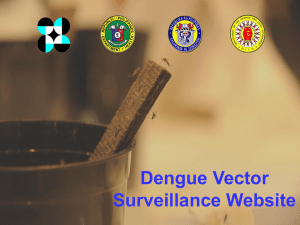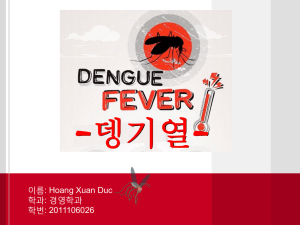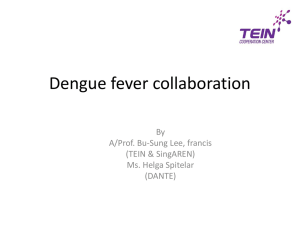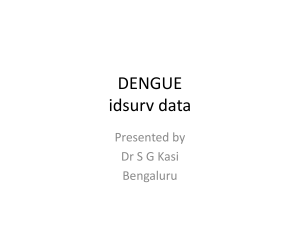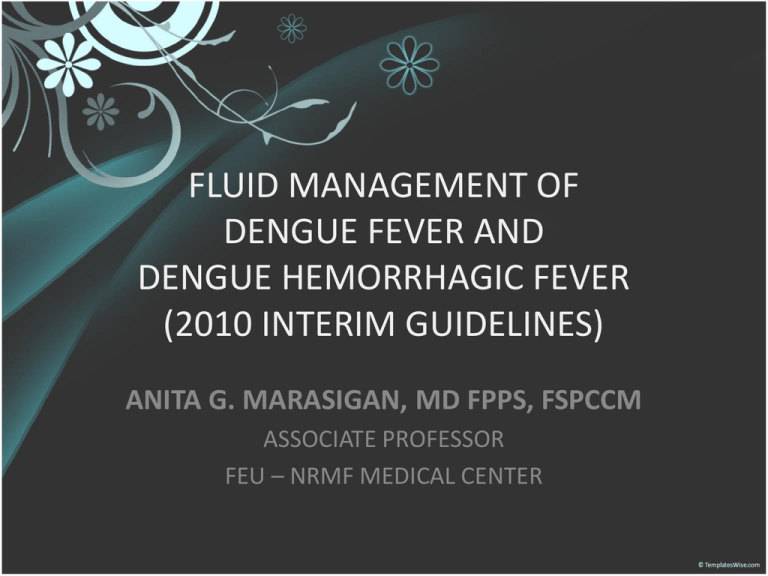
FLUID MANAGEMENT OF
DENGUE FEVER AND
DENGUE HEMORRHAGIC FEVER
(2010 INTERIM GUIDELINES)
ANITA G. MARASIGAN, MD FPPS, FSPCCM
ASSOCIATE PROFESSOR
FEU – NRMF MEDICAL CENTER
OBJECTIVES:
• To update the section on fluid management of
the 2008 PPS Dengue Evidence – based
guidelines.
• To develop clinical algorithms on fluid
resuscitation of patients with Dengue based
on clinical features.
Current WHO Case Definition of
Dengue and Levels of Severity (1997)
as adapted by the PPS Clinical
Practice Guidelines of Dengue 2008
Case Definition for Dengue
Fever
Proposed WHO Classification
and Levels of Severity 2009
Non severe Dengue w/o Warning Signs:
Probable:
• An acute febrile illness with 2 or
more of the following:
• headache
• Retro-orbital pain
• Arthralgia
• Rash
•Hemorrhagic manifestations
• Leukopenia
• Supportive serology
Probable Dengue:
• live in/travel to dengue endemic
areas.
• Fever and 2 of the following criteria
• Nausea
• Vomiting
• Rash
• Aches and Pains
• Tourniquet test positive
• Leukopenia
Confirmed:
• a case confirmed by laboratory
criteria
Laboratory Confirmed Dengue:
(impt. when no sign of plasma leakage)
Current WHO Case Definition of Dengue and
Levels of Severity (1997) as adapted by the PPS
Clinical Practice Guidelines of Dengue 2008
Case Definition for: Dengue Hemorrhagic Fever (DHF)
The Following must ALL be present:
1. Fever, or history of fever, lasting for 2 to 7 days,
occasionally biphasic
2. Hemorrhagic tendencies evidenced by at least one of
the following:
• (+) tourniquet test
• Petechiae, ecchymosis, purpura
• Bleeding from the mucosa, GIT, injection sites or other
locations
• Hematemesis or melena
Current WHO Case Definition of Dengue and
Levels of Severity (1997) as adapted by the PPS
Clinical Practice Guidelines of Dengue 2008
Case Definition for: Dengue Hemorrhagic Fever (DHF)
3. Thrombocytopenia (100,000 cells/mm3 or less)
4. Evidence of plasma leakage due to increased vascular
permeability, manifested by at least one of the
following:
• A rise in the hematocrit equal to or greater than 20% above
average for age, sex and population
• a drop in the hematocrit following volume replacement
treatment equal to or greater than 20% of baseline
• Signs of plasma leakage such as pleural effusion, ascites and
hypoproteinemia.
Current WHO Case Definition of Dengue and
Levels of Severity (1997) as adapted by the PPS
Clinical Practice Guidelines of Dengue 2008
Case Definition for: Dengue Shock Syndrome (DSS)
•All of the four criteria for DHF must be
present, plus evidence of circulatory failure
manifested by:
• Hypotension for age AND
• Cold, clammy skin and restlessness
Current WHO Case Definition of
Dengue and Levels of Severity (1997)
as adapted by the PPS Clinical Practice
Guidelines of Dengue 2008
Grading of Severity of DHF/DSS
DHF Grade I
• Fever accompanied by nonspecific constitutional signs &
symptoms such as anorexia,
vomiting, & abdominal pain
• The only hemorrhagic
manifestation is a (+)
tourniquet test &/or easy
bruising
Proposed WHO Classification and
Levels of Severity 2009
Non severe Dengue w/o
warning signs OR
Dengue w/ (Mild) warning signs
• Fever and 2 of the following
criteria:
• Nausea, Vomiting
• Rash
• Aches & pains
• Tourniquet test positive
• Leukopenia
• Any mild warning sign, eg. Mild
abdominal pain or tenderness,
mild liver enlargement
Current WHO Case Definition of
Dengue and Levels of Severity (1997)
as adapted by the PPS Clinical Practice
Guidelines of Dengue 2008
Proposed WHO Classification and
Levels of Severity 2009
Grading of Severity of DHF/DSS
DHF Grade II
• Spontaneous bleeding in
addition to manifestations of
Grade I patients usually in the
form of skin or other
hemorrhages
(mucocutaneous), GIT
Dengue w/ warning signs
•
•
•
•
•
•
•
Abdominal pain or tenderness
Persistent vomiting
Clinical fluid accumulation
Mucosal bleed
Lethargy, restlessness
Liver enlargement >2cm
Laboratory: increase in Hct
concurrent with rapid decrease in
platelet count
• Requires strict observation & medical
intervention
Current WHO Case Definition of
Dengue and Levels of Severity (1997)
as adapted by the PPS Clinical Practice
Guidelines of Dengue 2008
Proposed WHO Classification and
Levels of Severity 2009
DHF Grade III
Severe Dengue
• Circulatory failure manifested • Should be considered if the patient is
from an area of dengue risk
by rapid, weak pulse &
narrowing of pulse pressure or presenting with fever of 2-7 days plus
any of the following features:
hypotension w/ the presence • Severe plasma leakage, leading to:
of cold clammy skin and
• Shock
• Fluid accumulation w/ resp.
restlessness
DHF Grade IV
• Profound shock w. undetectable
blood pressure or pulse
distress
• Severe bleeding, as evaluated by the
clinician
• Severe organ impairment
• Liver: AST or ALT > 1000
• CNS: impaired consciousness
• Heart & other organs
Notes:
Shock
• Is a critical condition that results from
inadequate delivery of oxygen and
nutrients to the tissues to meet
metabolic demands.
• Characterized by:
• Inadequate perfusion
• Low cardiac output
SEVERITY OF SHOCK
• Compensated shock
– signs of reduced perfusion as long as SBP is
maintained
• Hypotensive shock
– When compensatory mechanism fails & SBP drops
– SBP of <90mmHg or MAP <70mmHg or
– SBP decrease of >40mmHg of <2 SD below normal
for age
ASSESSMENT
1.
2.
3.
4.
5.
6.
7.
8.
Level of consciousness
Heart rate – Increased
CRT – sluggish, delayed, > 2 secs.
Pulse pressure – narrow
Peripheral pulses – thready, absent
Blood pressure – decreased
Output – decreased (<1mL/kg/hr in infants)
(<30ml/kg/hr in adolescents)
Skin – cold, diaphoretic
TABLE 4: HEMODYNAMIC ASSESSMENT: CONTINUM OF HEMODYNAMIC CHANGES
PARAMETERS
STABLE
CONDITION
COMPENSATED SHOCK
HYPOTENSIVE
SHOCK
Sensorium
Clear &
Lucid
Clear & Lucid
(shock can be missed
if you don’t touch the
patient)
Change of
mental status
(restless &
combative)
CRT
Brisk
(<2sec )
Warm &
pink
Prolonged (>2sec)
Cool peripheries
Very prolonged,
mottled skin
Cold & clammy
Good
volume
Weak & thready
Feeble or absent
Extremities
Peripheral
Pulse
Source: WHO & Special Programme for Research & Training in Tropical Diseases, Dengue Guidelines for
Diagnosis, Treatment, Prevention & Control, 2009
TABLE 4: HEMODYNAMIC ASSESSMENT: CONTINUM OF HEMODYNAMIC CHANGES
PARAMETERS
Heart Rate
Blood
Pressure
Resp. Rate
STABLE
CONDITION
COMPENSATED
SHOCK
HYPOTENSIVE SHOCK
Normal for
age
Normal for
age
Normal pulse
pressure for
age
Tachycardia
Severe tachycardia w/
bradycardia in late shock
Normal for
age
Normal SBP but
Narrowed pulse
rising DBP.
pressure (<20mmHg)
Narrowing
Hypotension,
pulse pressure,
Unrecordable BP,
Postural
Metabolic Acidosis
hypotension
Tachypnea
Hyperpnea,
Kussmaul breathing
Source: WHO & Special Programme for Research & Training in Tropical Diseases, Dengue Guidelines for
Diagnosis, Treatment, Prevention & Control, 2009
Fluid Management of Dengue Fever
& Dengue Hemorrhagic Fever
• A. Fluid Management for patients w/ DF/DHF (Dengue w/o
warning signs) who are not admitted
– In patients w/ DF/DHF Grade I who are not admitted, oral
rehydration solution should be given as follows based on
weight, using currently recommended ORS
Body Weight (Kg)
ORS to be given
> 3-10
100 mL/kg/day
> 10-20
75 mL/kg/day
> 20–30
50-60 mL/kg/day
> 30-60
40-50 mL/kg/day
– Reduced osmolarity ORS containing Na 45 – 60mmol/L
– Sports drinks (Na), <20meqs should not be given
Fluid Management of Dengue Fever
& Dengue Hemorrhagic Fever
• B. Fluid Management for patients who are admitted, without
shock (DH/DHF Grade I & II or Dengue w/o warning signs
– Isotonic solutions (D5LRS, D5 Acetate Ringers, D5 NSS or
0.9 NaCl) are appropriate for DHF patients who are
admitted but without shock. Maintenance IVF computed
using the caloric expenditure method (Holliday Segar
Method) or calculation based on Weight (Barnes & Young
Method)
Body Weight (Kg)
Total Fluid Requirement (mL/day)
0-10
100 mL/kg
> 10-20
1000 mL + 50mL/kg for each kg > 10kg
> 20
1000 mL + 50mL/kg for each kg > 20kg
Fluid Management of Dengue Fever
& Dengue Hemorrhagic Fever
• If the patient shows signs of mild dehydration, the volume
needed for mild dehydration is added to maintenance fluids
over the next 6-8 hours.
• The following formula may be used to calculate the required
volume of intravenous fluid to infuse:
Maintenace IVF + Fluids as for Mild Dehydration
• Where volume of fluids for mild dehydration is computed as
follows (to be added to the maintenance fluid volume):
Infant
50ml/kg/6-8 hours
Older Child or Adult
30 mL/kg/6-8 hours
Fluid Management of Dengue Fever
& Dengue Hemorrhagic Fever
• Periodic reassessment is needed so that fluid rate
may be adjusted accordingly.
• After 6-8 hours, fluid rate is computed at
maintenance rate over 16-18 hours
• Clinical parameters should be monitored closely &
correlated w/ hematocrit. This will ensure adequate
hydration, avoiding under and over hydration. The
IVF rate may be decreased any time as needed.
C. Fluid Management for patients ADMITTED to the hospital w/ DHF GRADE III (Compensated Shock)
Compensated shock (systolic pressure maintained but has signs of
plasma leakage (hemoconcentration or reduced perfusion)
Box A. Obtain baseline Hct (a) Fluid resuscitation with plain isotonic
crystalloid 10-15ml/kg/hour over 1 hour. Give oxygen support
Yes
Box B. IV Crystalloid 5-7ml/kg/hr
for 1-2 hours, then reduce to 3-5
ml/kg/hr for 2-4 hours;
reduce to 2-3 ml/kg/hr for 2-4
hours;
Fluids should not exceed 3L/day
to avoid fluid overload.
If feasible, monitor Hct every 812 hours or as necessary (a)
Reassess hemodynamic status
frequently (see table 4)
including urine output (f)
Monitor signs of bleeding
Improvement (b)
See table 4
No
If patient is stable & Hct increases by 10% from baseline,
correlate clinically & assess need to increase fluid rate
If patient is unstable and Hct increases, go to Box B.
If patient is unstable & there is a sudden drop in Hct,
look for signs of bleeding. Consider transfusion w/ fresh
whole blood 20ml/kg or pRBC 10ml/kg
If patient is stable for 48 hours, stop IVF or give
maintenance fluids or ORS
C. Fluid Management for patients ADMITTED to the hospital w/ DHF GRADE III (Compensated Shock)
Compensated shock (systolic pressure maintained but has signs of
plasma leakage (hemoconcentration or reduced perfusion)
Box A. Obtain baseline Hct (a) Fluid resuscitation with plain isotonic
crystalloid 10-15ml/kg/hour over 1 hour. Give oxygen support
Yes
Improvement (b)
See table 4
Box B.
Box C. Administer 2nd bolus of fluid,
colloid/crystalloid (c ) 10-20ml/kg/hr in 1 hour
Patient is stable
Hct Decreases
Go to Box B
No
Patient is unstable
Hct Increases
Box D. If
there are
signs of
occult/ overt
bleeding
Administer 3rd bolus of fluid (colloid/
crystalloid) 10-20ml/kg/hr for 1 hour
If patient improves,
go to Box B
Box E. If patient does not improve,
consider inotropes (d) & refer to
tertiary center
C. Fluid Management for patients ADMITTED to the hospital w/ DHF GRADE III (Compensated Shock)
Compensated shock (systolic pressure maintained but has signs of
plasma leakage (hemoconcentration or reduced perfusion)
Box A. Obtain baseline Hct (a) Fluid resuscitation with plain isotonic
crystalloid 10-15ml/kg/hour over 1 hour. Give oxygen support
Yes
Box B.
Improvement (b)
See table 4
No
Box C.
If improved, go to Box B
If patient does not
improve, go to Box E
Box D. If there are signs of
occult/ overt bleeding, initiate
transfusion with fresh whole
blood 20ml/kg or prbc 10ml/kg
Reassess hemodynamic status &
bleeding parameters
D. Fluid Management for patients admitted to the hospital w/ shock DHF IV/DSS (Hypotensive Shock)
HYPOTENSIVE SHOCK
Box A. Obtain baseline Hct (a) fluid resuscitation w/ 20ml/kg plain
isotonic crystalloid or colloid over 15 mins. ( c). Give oxygen support
Yes
Box B. Crystalloid/ Colloid 10mL/kg/hr
for 1 hr, then continue w/:
5-7ml/kg/hr for 1-2 hrs;
Reduce to 3-5 ml/kg/hr for 2-4 hrs;
Reduce to 2-3 ml/kg/hr for 2-4 hrs.
Fluids should not exceed 3L/day to
avoid fluid overload.
If feasible, monitor Hct every 6 hrs or as
necessary. Reassess hemodynamic
status frequently (see table 4) including
output (f). Monitor signs of bleeding.
Improvement (b)
See table 4
No
If patient is stable & Hct increases by 10% from
baseline, correlate clinically & assess need to
increase fluid rate
If patient is unstable & Hct increases, go to Box B.
If patient is unstable & there is a sudden drop in
Hct, look for signs of bleeding. Consider
transfusion w/ fresh whole blood 20ml/kg or
pRBC 10ml/kg
If patient is stable for 48 hours, stop IVF or give
maintenance fluids or ORS
D. Fluid Management for patients admitted to the hospital w/ shock DHF IV/DSS (Hypotensive Shock)
HYPOTENSIVE SHOCK
Box A. Obtain baseline Hct (a) fluid resuscitation w/ 20ml/kg plain
isotonic crystalloid or colloid over 15 mins. ( c). Give oxygen support
Improvement (b)
See table 4
Yes
Box B.
Box C. Administer 2nd bolus of fluid, (colloid)
10-20ml/kg over ½ to 1 hr. Check
hemodynamic parameters (see table 4)
Patient is stable
Hct Decreases
Reduce IVF rate to 710ml/kg/hr for 1-2 hrs
If patient remains
stable, go to Box B.
Patient is unstable
Hct Increases
No
Box D. If there are signs of
occult/ overt bleeding initiate
transfusion w/ fresh whole
blood 20ml/kg or prbc 10ml/kg
Reassess hemodynamic status
& bleeding parameters
Administer 3rd bolus of fluid (colloid/
crystalloid) 10-20ml/kg/hr for 1 hour
If patient
improves,
go to Box B
Box E. If patient does not
improve, consider inotropes
(d) & refer to tertiary center
If improved,
go to Box B
If patient doesn’t
improve, go to Box E
Notes
• If Hct is not readily available, assess hemodynamic
status of patient using parameters in table 5.
• Assessment of improvement should be based on 7
parameters: mental status, heart rate, blood
pressure, respiratory rate, capillary refill time,
peripheral blood volume and extremities
Crystalloids
(Ringer’s Lactate or 0.9 NaCl Solutions
• Have been shown to be safe & effective as colloid solutions
(dextran, starch or gelatin
• Comparable to colloids in terms of total amount of fluids used
in resuscitation in moderately severe (compensated) dengue
shock8-12
• Colloids are associated with increased risk of allergic reactions
and new bleeding manifestations10-11
• Colloids may be used in patients who primarily present with
hemodynamic instability
8-12
Jalal SLR et al, The use of colloids and crystalloids in pediatric dengue shock; Dung NM et al, Fluid replacement in DSS; Ngan Ngo Thi et
al,. Acute management of dengue; Wills Ba et al, Comparison of 3 fluid solutions for resuscitation; Prasetyo RV et al Comparison of efficacy
and safety between hydroxyethyl starch and ringer lactate in children
10-11
Ngan Ngo Thi et al,. Acute management of dengue; Wills Ba et al, Comparison of 3 fluid solutions for resuscitation
Crystalloids
(0.9% saline/ Normal saline/ NSS)
• Saline is a suitable option for initial fluid
resuscitation, but repeated large volumes of 0.9%
saline may lead to hyperchloremic acidosis
• Hyperchloremic acidosis – may aggravate or be
confused with lactic acidosis from prolonged shock
• When serum Cl level exceeds normal range, it is
advisable to change the to other alternatives such as
Ringer’s lactate solution
Ringer’s Lactate
• Has lower Na (131mmol/L) and Cl (115mmol/L) and
osmolality of 273mOsm/L
• It may not be suitable for resuscitation of patients
with severe hyponatremia
• It is a suitable solution after 0.9 Saline has been
given and the serum Cl level has exceeded the
normal range
• Avoided in liver failure and patients taking metformin
where lactate metabolism may ne impaired
Colloids
• The types of Colloids are gelatin based, dextran
based & starch based solutions
• One of the biggest concerns regarding their use is
their impact on coagulation
• Dextrans – may bind to von Willebrand factor/Factor
VIII complex and impair coagulation the most
– Dextran 40 can potentially cause an osmotic renal injury in
hypovolemic patients
Colloids
• Gelatin
– has the least effect on coagulation among
all the colloids but has the highest risk of
allergic reaction
– Allergic reactions: Fever, chills and rigors
have also been observed in Dextran 70
Hypotension
• Systolic pressure of <90mmHg
• Mean arterial pressure of <70mmHg in adults
• Systolic blood pressure decrease of >40mmHg of <2
standard deviation below normal for age
• In children below 10 years of age the 5th centile for
systolic pressure can be determined by the following
formula:
– Systolic blood pressure = 70 + (age in yrs x 2)mmHg
Urine Output
• A good urine output indicates sufficient circulatory
volume and may be used as an index or guide for
decreasing the amount of fluid administered
• An adequate urine output is at least 1ml/kg/hr &
urine specific gravity of 1.020 is ideal
• WHO Dengue Guidelines 2009 – 0.5cc/kg/hr is
considered acceptable and may have been chosen to
avoid congestion in the course of the disease
• Monitor urine output hourly till the patient is out of
shock then 1-2 hourly
Inotropes
• The use of inotropes should be decided on carefully
and it should be started after adequate fluid volume
has been administered.
• To calculate the AMOUNT of DOPAMINE to be added
to 100 mL of IV base solution:
mg of Dopamine = 6 x desired dose (mcg/kg/min) x wt(kg)
desired fluid rate (ml/hr)
Inotropes
• To calculate the VOLUME of Drug to be added to 100 mL
of IV base solution:
mL of Dopamine = mg of drug (determined using formula above)
Concentration of drug (mg/mL)
• Preparation of Dopamine: 40mg/mL and
80mg/mL
Appendix A
Calculation of Fluids in Obese or Overweight Patients
For Obese & Overweight Patients, Use the Ideal Body Weight for Calculation of Fluid Infusion
Estimated Body
Weight or IBW (kg)
Normal Maintenance fluid
(mL/hr) based on HollidaySegar Formula
Fluid Regimen based
on 2-3ml/kg/hr
(ml/hr)
Regimen based on 1.52mL/hr (ml/hr)
5
10
10-15
10
20
20-30
15
30
30-45
20
60
40-60
25
65
50-75
30
70
60-90
35
75
70-105
40
80
80-120
50
90
100-150
60
100
90-120
70
110
105—140
80
120
120-150
Estimated Ideal Body Weight for Overweight
or Obese Adults
Height in cm
Estimated Ideal Body
weight in kg for Adult
Males
Estimated Ideal
Body weight in kg
for Adult Males
150
160
170
50
57
66
45.5
52
61.5
180
75
70
Causes of Fluid Overload
• Excessive and/or too rapid intravenous fluids
• Incorrect use of hypotonic rather than isotonic crystalloid solution
• Inappropriate use of large volumes of intravenous fluids in
patients with unrecognized severe bleeding
• Inappropriate transfusion of fresh-frozen plasma, platelet
concentrates and cryoprecipitates
• Continuation of intravenous fluids after plasma leakage has
resolved (24-48 hrs from defervescence)
• Co-morbid conditions such as congenital or ischemic heart
disease, chronic lung disease and renal disease
Early Clinical Features
of Fluid Overload
•
•
•
•
•
•
•
•
Respiratory distress, difficulty in breathing
Rapid breathing
Chest wall indrawing
Wheezing rather than crepitant rales
Large pleural effusions
Tense ascites
Increased jugular pressure
hypertension
Appendix C
Sample Monitoring Sheet for Dengue Patients
Parameters
Date
Time
Sensorium
Body temperature
Respiratory rate
Heart Rate
Bloo pressure
Pulse pressure/ volume
Capillary refill time
Temperature of extremities
Abdominal pain
Vomiting
Bleeding
IVF infusion rate
Urine Output
Time
Time
Members of the Technical Working Group
on the 2010 PPS Interim Guidelines
on Fluid Management of DF/DHF
•
•
•
•
Ma. Liza Antoinette M. Gonzales, MD: Overall Chair and Chair, Committee on Dengue,
HV/AIDS, another Emerging Infectious disease
Maria Anna P. Banez, MD: Co-chair, Committee on Dengue, HIV/AIDS, and other
Emerging Infectious Diseases
Members:
Cynthia A. Aguirre , MD
Benjamin T. Lim, MD
Gyneth Lourdes G. Bibera , MD
Anna Lisa T. Ong-Lim, MD
Rosario Z. Capeding , MD
Ma. Louisa U. Peralta , MD
Reynaldo C. De Castro, Jr. , MD
Anita G. Marasigan, MD
Flerida G. Hernandez , MD
Ma. Norma V. Zamora , MD
Magdalena Lagamayo , MD
Adviser: Arturo C. Ludan, MD
p
THANK YOU !

